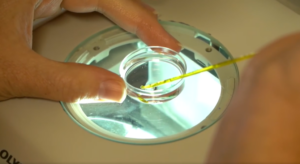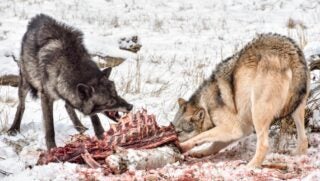There have been huge advances in bovine reproduction over the last 50 years. Some of these advancements include artificial insemination (AI), embryo transfer (ET), and in-vitro fertilization (IVF). These breeding techniques have allowed for faster genetic improvements, increasing production efficiency and reducing stress on pastureland. In the past, IVF wasn’t widely used due to cost and lower pregnancy rates. More recently, however, IVF has been providing even more opportunities for genetic improvements.
Here’s a little bit about how IVF works and some of the recent advancements with this technology:
IVF is similar to embryo transfer in the way that both methods allow you to produce multiple calves in a year that originate from a single cow. These cows, called donor cows, are generally genetically elite and the best cows in a herd.
IVF starts with the collection of unfertilized eggs, called oocytes, from the donor cow. This is done with a specialized probe that is inserted into follicles in the cow’s ovary and the contents of the follicle are aspirated out.
There are two ways that oocytes are collected from a donor cow. In a hormone system, follicle stimulating hormone (FSH) is given to the donor cow several days before the oocytes are collected. This grows the follicles on the ovary and makes them more visible to the technician during collection. In a hormone-free system, expert technicians use ultrasound equipment to find and collect the oocytes. One example of this system comes from the biotech company Vytelle. This type of system can save producers money because they don’t have the additional cost of FSH.
Another benefit of collection from a hormone-free system is that oocytes can be collected from heifers as young as six months, from cows up to 100 days pregnant, or as soon as 15 days after calving. That means a cow can have several offspring from multiple sires in the same amount of time one calf is produced through natural or artificial insemination breeding.
After collection, the oocytes are retrieved under a microscope, counted, and graded. Then the oocytes are put into a special maturation media that is designed to be as close to a cow as possible. After this, the oocytes are transported to a lab where they’ll sitting in the maturation media for 18 to 24 hours. One the maturation process is complete, semen is introduced with the goal of fertilizing the oocytes. The IVF process uses significantly less semen than AI, so it’s a great way to get more use out of an expensive bull.
After fertilization takes place, the oocytes sit in the lab for seven days to culture and develop into embryos. Once the seven days are up, the embryos are evaluated under a microscope and are quality graded. They are then quality-graded, and the embryos are ready to be either frozen or implanted into a donor cow while still fresh.
Embryos are quality graded following the IETS and American Embryo Transfer Association grading scale of 1-3, where Grade 1 is the highest quality and Grade 3 is the lowest quality. The result can have an impact on the plan for the embryos. Some producers choose to freeze Grade 1 embryos since they are more likely to have a higher conception rate after being frozen and thawed than the lower grades.

IVF is an amazing breeding technique for a few reasons: First, you can improve your genetics at a faster rate. In one year, you can collect oocytes and have multiple pregnancies from one genetically elite donor cow. If you have an expensive straw of semen, you can also have multiple pregnancies from just one straw. Depending on quality, one straw of conventional semen can fertilize oocytes from as many as 15 donors.
The IVF procedure can also be repeated more often than other methods of breeding. Donors are often on bi-weekly schedules. During a 90-day period a donor could be aspirated up to six times. Within a given time frame, more total pregnancies can be created through an IVF program when compared to embryo transfer.
All that said, IVF also has its downsides. One of those being the cost, despite it gradually becoming more affordable. IVF has gotten more widespread, but it still costs more than other reproduction methods like AI or traditional live cover. Embryos developed in a lab are not as hearty as those produced from ET. This means that IVF can have lower pregnancy rates.
There is also no industry-standard method of freezing embryos, so pregnancy rates can be lower from frozen embryos than those that are implanted while still fresh.
In vitro fertilization (IVF) has allowed cattle producers (both beef and dairy) to make huge strides in genetic improvements. This fascinating reproduction method is still making advancements and changing as new breakthroughs are reached. One of the most recent changes includes the hormone-free collection of oocytes. IVF allows producers to get more pregnancies out of their elite animals. It’ll be interesting to see how IVF continues to change and improve over time!
Michelle Miller, the Farm Babe, is a farmer, public speaker, and writer who has worked for years with row crops, beef cattle, and sheep. She believes education is key in bridging the gap between farmers and consumers.



